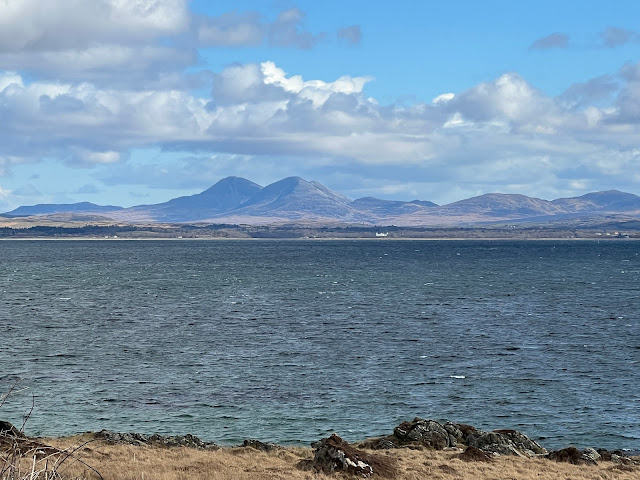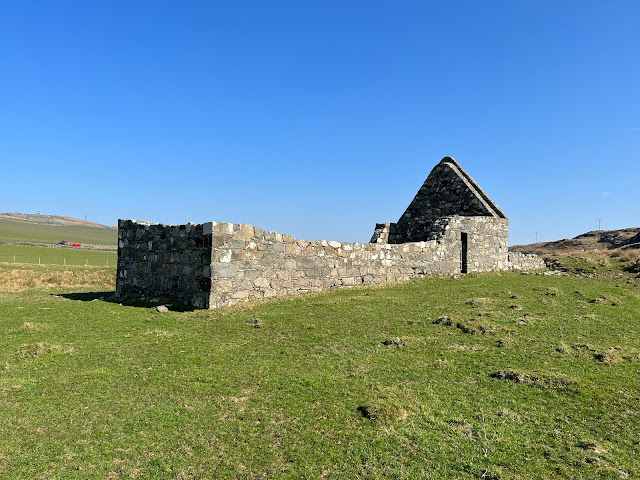Our first trip of 2022 was supposed to take in both the islands of Jura as well as Islay but due to various logistical problems we only managed to visit Islay, so a further visit next year is on the cards to make sure we do not miss out on Jura. But don’t get me wrong I’m not complaining as our eight nights on the beautiful Islay accompanied by wall to wall sunshine was a real treat.
 |
| Outgoing Ferry |
 |
| Approaching Islay. |
 |
| Port Askaig.
|
For the uninitiated Islay lies in the Inner Hebrides to the west of the Kintyre peninsula and can be reached by ferry from Kennacraig Terminal to either Port Askaig or Port Ellen. Although the ferries can be a tad unreliable due to disruption due to the weather conditions and/or breakdowns. New ferries are at present being built in Turkey which should improve the service in due course.
 |
| Roe Deer. |
 |
| A varied selection of Birds. |
 |
| The peace and quiet of our location. |
The Island is now probably best known world wide for its nine single malt whisky distilleries which utilise the island extensive areas of peat. This in its self encourages visitors and at certain times of the year fill the large amount of holiday homes. Islay Festival at the end of May celebrates traditional Scottish music and whisky when owners can charge as much as £1000 per week! But i would rather the island be best known for its beautiful landscapes, quiet roads, friendly people and wildlife.
The journey up was broken by a one night stay at Lochgilphead Caravan Park which has been greatly improved since our last visit in 2017. From there its a short journey to Kennacraig Terminal and across to Port Askaig.
 |
| Facilities block and restaurant. |
Our permanent stay was on the community run Port Mor Centre and Campsite whose 10 hook up pitches are located over looking Loch Indaal and out to the Atlantic. This site is very well run with great facilities that are warm and very clean. On the site is also a restaurant which boasts a very good menu. Wild camping with a Motorhome is not encouraged on the Island.
 |
| Port Charlotte. |
 |
| Loch Indaall Lighthouse. |
 |
| The Museum of Islay Life. |
 |
| An interesting grave stone in the museum grounds. |
You are a short walk from the nearest village where there is a Spar which stocks most essentials. Port Charlotte is a pretty white washed village which has a small harbour and lighthouse. The village dates from 1828 and was named after Walter Frederick Campbells mother. Campbell was MP for Argyllshire during the 19th century and he built the village, along with others to avoid clearances and mass emigration. Although I'm sure he would not approve of the large amount of holiday lets available in the village they do encourage tourists with deep pockets.
As the side roads are very quiet its grand place to unload the bikes and get exploring. Our first outing was a circular ride to Portnahaven and Port Wemyss.
Our journey took us via Kilchiaran where on a hillside terrace overlooking Kilchiaran Bay stands the roofless ruin of a 13th century chapel dedicated to the Irish monk St Ciaron or Kiaran. The chapel is a simple rectangle with walls up to gable height at the east side.
 |
| The Priest. |
Inside the nave there are a large number of medieval grave slabs dating back to the 13th century. The most interesting of which is carved with the effigy of a priest in robes, his hands clasped in prayer, actually its quite spooky!
 |
| Portnhaven for our piece. |
 |
| Portnhaven. |
From there onto Portnaheven for our piece and a well earned rest on a public bench high up over looking the bay what was developed as a fishing village in the early 19th century absorbing crofters cleared from the land. It is now very much a holiday village although there a lack of facilities, even the public house is closed.
\
 |
| Orsay Lighthouse. |
Immediately south of Portnaheven lies another wee village, Port Wemyss, again developed originally as a fishing village and on the island opposite their stands the Orsay lighthouse built by our old friend Robert Stevenson in 1825. from here we completed our ride back to Port Mor via the coast road.
 |
| Loch Gorm. |
Our second cycle ride was a little longer. Heading north from the campsite via Bruichladdic to Traight an Luig and then left following the Rinns of Islay to enjoy the views across the largest fresh water loch on Islay. Loch Gorm is
home to a great deal of wild life and also famous for its abundance of Brown Trout.
In the south east corner of the Loch is a small island which houses the overgrown ruins of Loch Gorm castle, a former fort from MacDonald clan which was destroyed in the 1700s. (Very difficult to see from the road)
 |
| Machir Bay. |
Then mainly a down hill journey to the beaches that form Machir Bay. A very enjoyable walk along the vast stretches of the beautiful sandy beach followed before sitting in the sunshine, which was making a regular appearance, for our lunch.
 |
| Kilchoman Parish Church. |
A wee detour up to the village of Kilchoman and its parish church which was built in 1827 to serve what was a large community but due to depopulation and clearances with only a few inhabitants remaining, the church ceased to be in use from 1977 and gradually fell into disrepair and its this sad ruin you see today.
Cross a nearby field and you will come to the Kilchoman Military Cemetery.
“The Kilchoman Military Cemetery contains 74 graves; 71 from the Otranto (of whom 43 remain unidentified) and 3 other casualties brought from elsewhere. The grave slabs are all similar except the one of Captain Ernest George Davidson, the captain of H.M.S. Otranto, which stands out from the rest. Shortly after the sinking of the Otranto the remains of American Troops were buried here as well but their bodies were later repatriated or reburied in the American military cemetery at Brookwood in Surrey. The large memorial cross overlooks Machir Bay in the west, the very place where the tragedy with the Otranto took place.”
With this ride you have to return the way you come but this was not a problem as it was as enjoyable both ways.
 |
| Bowmore Distillery |
The bus service on the island is not brilliant but time it right and you should be ok, the 450 stops out side the campsite if requested. Catching the 9:50 we travelled through Bridgend to Bowmore the administrative capital of the island. It is of course famous for its distillery, dating back before 1816, which produces the Bowmore single malt scotch whisky. One of the distillery warehouses was gifted to the community for conversion to a swimming pool and leisure centre which uses a clever system of underground pipes to transfer heat from the distillery to heat the water for the swimming pool.
 |
| The Round Church. |
At the head of the village stands Kilarrow Church, known locally as the Round Church because of its unique design. It was built between 1767 and 1769 by Danial Campbell who at the time owned the complete Island. Around 1770 Campbell expanded Bowmore to allow clearance of the areas main settlement of Kilarrow because he wanted to extend the gardens and grounds around his hereditary home. That’s money and power for you!
 |
| Bowmore from the Harbour. |
 |
| Main Street. |
Bowmore has a reasonable size supermarket and plenty of places to eat including the Bakery for coffee and cake which is next to the Munchie Box which serves a first class fish supper to take away.
That evening on our return to Port Mor we managed at long last to see a creature that we were beginning to think did not exist - The Otter. Watching this scarce carnivorous mammals hunting and eating fish just in front of your eyes was a rare treat and something you wouldn't ever forget.

Previous to our coming away we had purchased a Footprint walking guide, the walk we chose started a short walking distance from the campsite and was supposed to be an easy walk of 2.5 miles. The first part was up the main road via Port Charlotte, passed the lighthouse turning left passing what was the manse. So far so good but, and a big but at that, the remaining part of this circular walk and its landmarks was none existent! We did finish the walk but because of some very rough and dangerous ground it was far harder than we anticipated, breaking my walking pole didn't help and was nearer to 4 miles than 2.5. Now we are keen walkers and are used to following routes set out in guide books but this one was impossible. So i have no idea what the rest of the Footprint “easy to follow walks’ are like i dread to think.
 |
| Port Ellen. |
 |
| Ferry back to Kennacraig. |
Our final day saw us heading to Port Ellen to catch the 12:45 ferry back across to the mainland. Originally we were to catch then 9:45 but due to the extension of the MV Finlaggans overhaul a relief vessel was operating with a reduced capacity hence our later sailing. The relief ferry was normally used for Isle of Arran!
Our journey home include a two night stay at Lomond Woods Holiday Park at the southern end of Loch Lomond and because of its close proximity to Glasgow was very busy something we were not used too after the peace and quiet of Port Mor. But it gave us the chance to have a walk into the town of Balloch.
 |
| The Maid of the Loch. |
We also got to see the Maid of the Loch which was the last paddle steamer to be built in a Glasgow shipyard and the largest inland water passenger steamer in Britain. Launched in 1953 and taken out of service in 1981 the Maid of the Loch is at present being restored by a charity who hope eventually to have her operating back on the Loch.
 |
| Loch Lomond. |

























































No comments:
Post a Comment